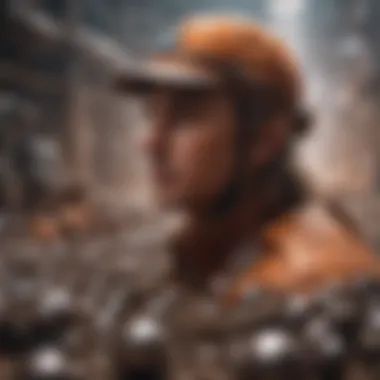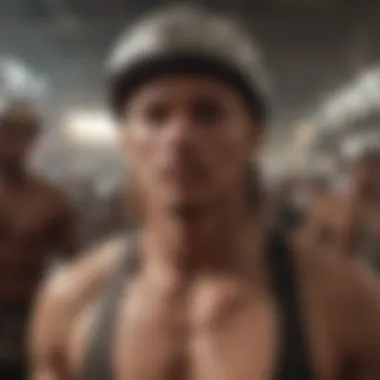Exploring the Depths of Steel Ball Run


Intro
The world of comic literature often engages with complex themes and rich character arcs. One distinct example is found in the series titled Steel Ball Run, part of the broader JoJo's Bizarre Adventure. This section offers an introduction to the myriad narrative elements that shape it.
Steel Ball Run breaks conventional boundaries and explores philosophical aspects, historical references, and various social themes. It moves beyond traditional superhero tropes to delve into the darker corridors of human nature and moral ambiguities.
Through its compelling characters and their unique journeys, the series engages readers on multiple levels, promising more than mere entertainment. The thematic depth and intricate storytelling render it a significant subject for those interested in both pop culture and literary analysis.
The ensuing sections will explore these dimensions, offering insights into the artistic choices made by the creator and the cultural impact it has had, as well as how it reflects the current state of the comic industry.
"Understanding Steel Ball Run provides crucial insights into emotional depth often overlooked in mainstream comics."
The article will navigate through various influences, providing an understanding of why this series holds a critical place within comic literature.
Foreword to Steel Ball Run
Steel Ball Run represents a significant chapter in the expansive narrative of the JoJo's Bizarre Adventure series. This work not only advances the evolving storyline but also introduces new thematic elements that resonate deeply with the modern audience. It functions as both a continuation and a transformation of the established JoJo legacy. By examining this series, one can better understand how it has redefined characters and themes within the framework of manga and anime culture.
Historical Context
The year 2004 marked a pivotal moment for the manga landscape, as Steel Ball Run debuted. Set against the backdrop of American history during the late 19th century, the story parallels real-world events, intertwining them with fantastical elements. This era witnessed significant changes in transportation and exploration, mirroring the ambitions of characters in their pursuit of the Steel Ball Run race. This historical context enriches the narrative, making it not only entertaining but also thought-provoking.
The themes of expansion and discovery are central to America during this time, reflecting a nation grappling with its identity amid rapid change. This setting profoundly influences the characterization and plot development throughout the series. The position of race and competition amidst societal growth invites dialogue about personal ambition versus collective fate.
Overview of the JoJo's Bizarre Adventure Franchise
JoJo's Bizarre Adventure has established itself as a cornerstone of manga and anime, with its roots stretching back to 1987. Hirohiko Araki, the creator, has consistently pushed narrative boundaries. The franchise is recognized for its unique art style, memorable characters, and inventive storytelling. Each part of the series, including Steel Ball Run, contributes a distinct flavor while maintaining the core themes of family, destiny, and conflict.
The franchise's mix of supernatural abilities known as Stands, along with its signature battles, serves as both entertainment and a means to explore deeper philosophical questions. Through the years, it has garnered a diverse fan base, embracing those who appreciate intricate narratives and complex character arcs. Steel Ball Run serves as a reflection on both personal and societal struggles, transcending mere entertainment to become a topic of critical analysis within the pop culture landscape.
"The true essence of JoJo's Bizarre Adventure lies in its ability to blend history, fantasy, and compelling character development, creating a rich tapestry of narratives that challenge and engage readers." - Anonymous
In this article, we will delve deeper into the themes, characters, and cultural impact of Steel Ball Run, celebrating its contribution to the wider comic literature.
Thematic Exploration
Thematic exploration serves as an integral element in understanding the narrative depth of Steel Ball Run. This section examines how the different themes interconnect and contribute to the overarching plot and character development. Analyzing themes such as identity, justice, morality, and the ideals surrounding the American Dream allows us to recognize the complexities of the characters and their actions. Moreover, these themes resonate with broader societal issues, making them pertinent not just within the narrative but also in the context of real-world paradigms.
Identity and Transformation
Identity in Steel Ball Run is vital for character development and drives the story forward. Johnny Joestar exemplifies this theme through his self-discovery and evolution from a paralyzed young man into a determined participant in the Steel Ball Run race. His struggle with identity mirrors the larger journey of many characters who face challenges in understanding who they are. Gyro Zeppeli, as Johnny's mentor, also showcases transformation. He embodies personal growth, moving from a self-centered warrior to someone willing to sacrifice for his beliefs. This dynamic interaction emphasizes how relationships catalyze self-discovery. The journey each character undertakes reveals the fluctuating nature of identity, which resonates deeply with readers experiencing their own individual transformations.


Justice and Morality
Steel Ball Run raises pertinent questions about justice and morality. Characters grapple with the consequences of their actions amidst a chaotic backdrop of greed and ambition. The narrative paints a complex picture of morality. For instance, characters often find themselves at odds with traditional definitions of right and wrong. Johnny's quest for redemption forces him to confront moral dilemmas that challenge his understanding of what is just. The interplay between personal ethics and societal norms forces readers to ponder the variability of justice. The race itself symbolizes a battleground not only for the characters but also for the moral compass guiding their choices. Each character's decision impacts not just their fate but the fate of those around them, highlighting the interconnectedness of morality in the human experience.
The American Dream
The theme of the American Dream in Steel Ball Run is explored through various lenses, particularly through the motivations of the participants. Many characters enter the race seeking fame, fortune, and validation. However, the story critically examines these pursuits by showing the often harsh realities that accompany ambition. The American Dream is depicted as both an aspiration and a potential illusion. Characters like Funny Valentine present a duality; while he embodies the pursuit of power and national identity, his actions reveal the darker sides of ambition and the sacrifices made in its name. Ultimately, the narrative challenges the notion of the American Dream, prompting readers to question whether the pursuit of personal success is worth the moral compromises it may entail. This provides a rich ground for reflection within the contemporary socio-political landscape.
In Steel Ball Run, the exploration of themes not only enhances narrative depth but also encourages critical thought on identity, justice, and social aspirations.
Character Analysis
The character analysis section of this article holds significant importance. It allows readers to understand the complexity and depth of the individuals that inhabit the world of Steel Ball Run. Characters like Johnny Joestar and Gyro Zeppeli offer a window into the broader themes of the narrative, such as identity, transformation, and morality. By examining the characters, one can also appreciate their contributions not only to the story but also to the cultural impact of the series. In doing so, this section uncovers the subtleties in the character dynamics, illustrating how they resonate with the audience.
Johnny Joestar: The Anti-Hero
Johnny Joestar stands out as a compelling anti-hero in Steel Ball Run. Initially, he is portrayed as a man grappling with his paralysis and identity. His journey reflects a significant transformation; he evolves from someone consumed by bitterness to a more complex character who embodies resilience.
His inner struggles resonate with themes of loss and redemption. By utilizing the Stand power of Tusk Act 1, he learns to navigate his limitations and ultimately redefine his sense of self. Johnny's growth personifies the idea of overcoming adversity, making him relatable to many readers.
Further, his conflicts with other characters, particularly Gyro, highlight his internal dilemmas and motivations. The interplay between their personalities creates tension and drives the narrative forward.
Gyro Zeppeli: The Mentor Figure
Gyro Zeppeli serves as a mentor to Johnny, guiding him through the challenges of the Steel Ball Run. His character is marked by a profound sense of purpose and wisdom, influencing Johnny in more ways than one. Gyro’s knowledge of the Spin technique showcases a blend of skill and intellectual foresight. Through Gyro, themes of mentorship and friendship emerge, providing a rich layer to the narrative. His backstory reveals a deep commitment to personal ideals, setting him apart from other characters. While he teaches Johnny about the significance of the race, he also imparts valuable life lessons about courage and sacrifice. Gyro's eventual fate adds an emotional weight to the story, showing that even great mentors have their struggles.
Supporting Characters: A Diverse Cast
The supporting characters in Steel Ball Run are varied and multilayered. Each one contributes to the narrative and underpins the broader themes presented throughout the story.
- Hot Pants: She is a strong and determined character. Her hidden motives and fierce loyalty to her cause challenge Johnny and Gyro, adding depth to the plot.
- Funny Valentine: As an antagonist, he represents a complex view of justice and morality. His vision of achieving peace, albeit through morally ambiguous methods, gives readers a chance to explore different perspectives on leadership.
- Mountain Tim: He embodies the American spirit, showcasing themes of hope and resilience in the face of numerous challenges.
The collective presence of these characters enriches the story’s landscape. Moreover, they demonstrate the full spectrum of human emotions and motives, from altruism to selfishness. This diverse cast invites readers to reflect on the complexities of the human condition, making Steel Ball Run a multifaceted work that resonates on many levels.
"The characters in Steel Ball Run are not just figures in a narrative; they represent a wide array of human experiences and dilemmas."
Through this character analysis, we gain insight into the essential threads that weave together the narrative of Steel Ball Run. Each individual's journey ties into the overarching themes and cultural impact that define this work.
Artistic Style and Pacing
Artistic style and pacing are crucial elements in any narrative, particularly in a complex work like Steel Ball Run. This segment explores the distinctive visual language and narrative rhythm employed by Hirohiko Araki. The interplay between art and storytelling can significantly influence a reader’s experience, establishing a profound connection to the overarching themes and character development. A well-considered artistic style not only enhances the aesthetic appeal but also serves to underscore the thematic depth present in the work. Pacing, on the other hand, keeps the narrative engaging, ensuring that the plot unfolds in a way that prompts intrigue and retention.
Visual Aesthetics of Steel Ball Run
Steel Ball Run showcases a striking visual aesthetic that is both innovative and reflective of the story's tone. The characters exhibit intricate designs, each marked by distinct features and expressions that convey their personalities and motivations. The use of color is also noteworthy. Bright, saturated colors create an energetic atmosphere while more muted tones are reserved for moments of tension or introspection. This dual approach to color applies to the various settings as well, with vibrant landscapes juxtaposed against darker, more oppressive environments.
Additionally, the intricate detail in the character drawings and backgrounds provides a rich context for the narrative. The horses and the vast American landscapes come alive through meticulous line work. Such attention to aesthetics invites the reader to immerse themselves fully in the world of Steel Ball Run, heightening emotional engagement and enhancing the overall reading experience.


Effective visuals create a narrative that resonates with readers long after they’ve turned the page.
Panel Layout and Storytelling Techniques
The panel layout in Steel Ball Run is a crucial contributor to the storytelling. Araki deftly employs various panel sizes and arrangements to manipulate pacing and emphasize key moments. For example, larger panels often depict significant events with more dramatic impact, while smaller panels convey rapid action sequences or quick interactions between characters. This dynamic arrangement not only leads the reader through the scenes but also reflects the emotional intensity of the unfolding narrative.
Moreover, the use of diagonal lines and angled panels creates a sense of movement and urgency that enhances the action. Thoughtful placement of sound effects and dialogue balloons guides the reader’s eye and maintains a steady flow in the reading experience. Furthermore, Araki’s technique of varying the layout assists in building tension, as the reader becomes eager to see how each scene connects.
Cultural and Socio-Political Commentary
The cultural and socio-political commentary found in Steel Ball Run serves as a vital lens through which readers can examine the narrative's multilayered significance. This commentary extends beyond mere backdrop; it highlights the complexities of American society in the 19th century, addressing issues such as identity, power, and the myth of opportunity. Understanding these elements enriches the reader's experience and provides parallels to contemporary social dynamics.
Reflections on American Society
Steel Ball Run is set against the backdrop of the American landscape during the Gilded Age, a period characterized by rapid economic growth, social upheaval, and stark contrasts between wealth and poverty. The series portrays a diverse range of characters whose journeys reflect various aspects of American life.
- Pioneer Spirit: Many characters exhibit a form of resilience similar to that of pioneers, striving for their own version of the American Dream. This is portrayed through their personal quests, which often comment on the nature of success—be it financial, social, or personal.
- Social Stratification: The narrative delves into the disparities in social class and treatment of marginalized groups, such as Native Americans and African Americans. Characters encounter discrimination and injustice, illustrating the harsh realities of a society purportedly built on equality and opportunity.
- Historical Parallels: The race itself serves as a metaphor for the pursuit of happiness and prosperity. Each character's motivation captures the essence of ambition while also critiquing the sometimes ruthless means by which individuals pursue their goals.
"The intersection of personal ambition and societal expectation shapes the journey of each participant in the race, revealing both the desires and flaws inherent in the quest for the American Dream."
Through these reflections, the series encourages readers to reflect critically on the reflections of their own society while also recognizing the universal themes of struggle and resilience.
Historical Figures and Their Representation
Steel Ball Run intricately weaves historical figures into its fictional fabric, enhancing both the plot and the thematic discourse of the series.
- Ulysses S. Grant: Former president and Union general, Grant is depicted not just as a historical icon but also as a flawed individual navigating the complexities of power. His presence in the narrative touches on themes of leadership, corruption, and redemption.
- Other Historical Characters: Figures like the notorious outlaw, Jesse James, and even mythologized others connect the comic to broader American folklore. By integrating these characters, the narrative emphasizes that history is often a blend of fact and fiction, reshaping perceptions of national identity.
- Cultural Significance: The treatment of these figures provides a critical examination of how history is romanticized or vilified. Readers may recognize the contrast between popular portrayals of these figures in media and their actual historical contexts, inviting deeper reflection on historical narratives and collective memory.
In this manner, the series not only entertains but also educates, prompting readers to reevaluate the societal norms and historical truths that shape modern perspectives.
Critical Reception
The critical reception of Steel Ball Run plays a pivotal role in understanding its significance within the JoJo's Bizarre Adventure franchise. This section discusses the variety of responses it has garnered from both fans and critics. It reflects on how these reviews and ratings can shape the perception of the work. The evaluation of Steel Ball Run not only highlights its artistic merit but also its cultural relevance, making this analysis essential for a comprehensive understanding of the series.
Reviews and Ratings
Steel Ball Run has received substantial acclaim since its debut. Although opinions vary, the consensus amongst most reviews leans toward the positive. Notably, many critics praise the intricate storytelling and character development. For instance, sites like MyAnimeList and Goodreads showcase high average ratings that signify strong fan approval. Some notable points regarding reviews include:
- Narrative Complexity: Reviewers often emphasize the depth of its plot and the philosophical questions it raises. The multilayered narrative is frequently cited as a high point.
- Character Depth: Critics appreciate how characters evolve throughout the series. The struggles and growth of Johnny Joestar resonate well with audiences.
- Artistic Quality: The artwork is another focal point of praise. Hirohiko Araki's distinctive style continues to captivate readers, reinforcing the visual storytelling aspects.
In summary, the reviews depict Steel Ball Run as a defining installment that deepens the lore of the JoJo series while experimenting with various themes.


Influence on the Genre
Steel Ball Run has not only impacted its immediate franchise but also has broader implications for the manga and anime genre. Its publication marked a shift in how stories could be woven together in this medium. Some notable influences include:
- Integration of Historical Context: Steel Ball Run weaves historical figures into its narrative, influencing how future manga series approach character development and storytelling.
- Redefinition of Battle Concepts: The series expands the idea of battles in shonen manga, moving beyond simple physical confrontations to include tactical and psychological elements. This has encouraged new works to explore deeper mechanics in their conflicts.
- Thematic Richness: Many subsequent series have aimed to incorporate complex themes such as identity, morality, and societal critique, inspired by Steel Ball Run's thematic approach.
Ultimately, Steel Ball Run stands as a benchmark for future works. Its critical reception not only highlights its quality but also its role in shaping broader trends within the genre.
Legacy of Steel Ball Run
The legacy of Steel Ball Run is significant and multi-layered. As a part of the JoJo's Bizarre Adventure franchise, this installment stands as an innovative work that reshapes the perception of the series itself. It showcases how storytelling can evolve without losing its core. The narrative complexity combined with rich themes generates a lasting impact on both readers and creators.
Impact on Subsequent Works
The influence of Steel Ball Run on later manga and anime cannot be overstated. It introduces intricate storytelling methods that prioritize character depth and moral ambiguity. This development alters the landscape of shōnen manga, where characters often fall into clear categories of hero and villain. In many ways, Johnny Joestar's journey acts as a template for flawed yet relatable protagonists in modern manga. New works often echo the themes of transformation and identity introduced in Steel Ball Run, indicating that the lessons learned from this narrative continue to resonate.
Moreover, creators within and beyond the realm of JoJo's Bizarre Adventure have begun to adopt similar traits. Complex characters and a focus on emotional development are now more prevalent. The blend of historical context with fictional narrative, as seen in Steel Ball Run, also influences how storytelling operates within the genre, encouraging deeper engagement from audiences. Adaptations such as video games and fan art often channel the innovative aspects of this arc, signifying its profound effect.
Merchandise and Adaptations
Steel Ball Run has expanded its legacy through a variety of merchandise and adaptations. The popularity of the series has surged, resulting in extensive merchandise that includes action figures, apparel, and even collectible cards. This extension enhances the audience's engagement and appreciation of the work.
Adaptations of Steel Ball Run into other media forms show the series' adaptability. Animation projects and video games have emerged, catering to a wide audience base. For example, the JoJo’s Bizarre Adventure: Steel Ball Run video game allows fans to immerse themselves in the storyline, offering interactive experiences that deepen understanding of characters and their journeys.
Additionally, fan interpretations and artworks often celebrate pivotal moments from the series. Platforms like Reddit showcase extensive discussions and theories, helping to ensure that the legacy of Steel Ball Run remains a living part of the JoJo community. This continuous engagement contributes toward reinforcing its status within pop culture.
"Steel Ball Run serves not just as a narrative but as a cultural phenomenon that continues to inspire discussion and creation in the manga community."
Overall, the enduring legacy of Steel Ball Run is evident in its lasting impact on subsequent works and in the extensive merchandise and adaptations inspired by it. Through character exploration and thematic depth, it not only redefined its own franchise but also set a benchmark for future storytelling in manga.
Ending
The conclusion serves as a crucial element of the article by encapsulating the essence of the discussions and analysis presented throughout. It is where the key insights gained from the exploration of Steel Ball Run are synthesized, allowing readers to reflect on the multifaceted nature of this narrative. Summaries of major themes, character evolution, artistic techniques, and cultural reflections should reinforce the notion that Steel Ball Run is not just a simple continuation in the JoJo's Bizarre Adventure series but a significant work that challenges and expands the boundaries of comic literature.
Moreover, the conclusion highlights the ongoing relevance of the series, discussing how its themes resonate in current societal contexts, while also looking forward to future implications for the franchise. This retrospective and prospective analysis connects the past with possible future developments, ensuring that fans and scholars alike appreciate the lasting impact of the work.
Summation of Key Insights
The key insights from Steel Ball Run can be summarized as follows:
- Identity and Transformation: The characters undergo profound changes that reflect their inner struggles and aspirations.
- Justice and Morality: The narrative poses challenging questions about justice, showcasing different interpretations and actions in the name of morality.
- Cultural Commentary: The story's backdrop offers insightful reflections on American history, society, and values, allowing for critical examination through the lens of a fictional race.
- Artistic Dynamics: The unique visual style coupled with innovative storytelling techniques enriches the reading experience and keeps the audience engaged.
These points showcase the depth of Steel Ball Run and its contribution to not only the JoJo's Bizarre Adventure series but also to the broader context of comic arts.
Future Prospects for JoJo's Bizarre Adventure
Looking forward, the JoJo's Bizarre Adventure series continues to hold immense potential for further exploration. Future installments can delve deeper into unresolved themes or develop new ones in response to evolving societal conversations. Additionally, the legacy of Steel Ball Run has opened avenues for adaptations across various media, further solidifying its place in contemporary pop culture.
The anticipation for new story arcs or adaptations, coupled with the ongoing fascination with its characters, ensures that the franchise will maintain its relevance for years to come. As new generations discover this extraordinary series, the significance of Steel Ball Run will likely be re-evaluated and appreciated anew.



